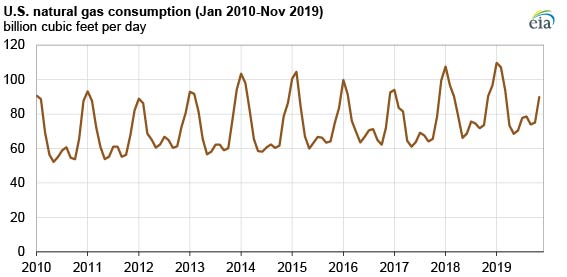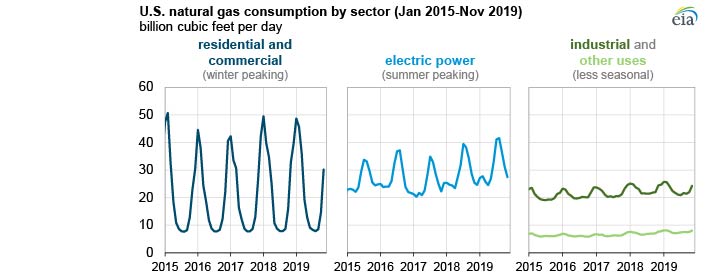
Natural gas consumption in the United States has two seasonal peaks, largely reflecting weather-related fluctuations in energy demand. In the winter months, cold weather leads to more demand for heating in the residential and commercial sectors. In the summer months, warm weather leads to more demand for air conditioning and, in turn, more demand for electricity. Because natural gas continues to account for an increasing share of the fuels used to generate electricity in the United States, natural gas consumption by the electric power sector has increased throughout the year.
In winter months, natural gas is used directly in furnaces, boilers, and other natural gas-fueled heating equipment in homes and businesses. The U.S. Energy Information Administration’s (EIA) most recent surveys of energy use in the residential and commercial sectors showed natural gas accounted for 68% of heating consumption in homes in 2015 and 76% of heating consumption in commercial buildings in 2012. The residential and commercial sectors consumed 49 billion cubic feet per day (Bcf/d) of natural gas in January 2019, or nearly half of the national total.
During winter, homes and businesses also use heat pumps, electric radiators, space heaters, and other electric heating equipment. That equipment uses electricity, which is generated in part by natural gas, resulting in additional heating-related consumption of natural gas in the winter months. In January 2019, natural gas-fired generators provided 33% of the nation’s electricity, and natural gas-fired power plants consumed 27 Bcf/d of natural gas to generate that electricity.
In the summer, as temperatures and humidity increase, homes and businesses use air conditioning, and electricity demand increases. In 2019, U.S. electricity generation was highest in July; in that month, natural gas generated 42% of the nation’s electricity and natural gas-fired power plants consumed 41 Bcf/d of natural gas.

In the spring and fall, relatively mild temperatures reduce the need for both heating and cooling. In those seasons, natural gas consumption in the residential and commercial sectors is generally limited to uses such as water heating, cooking, and combined-heat-and-power applications, which tend to have less seasonal fluctuation in consumption.
Industrial consumption of natural gas is not very seasonal but is still highest in the winter, likely reflecting some heating-related industrial applications. Other consumption of natural gas, including pipeline and distribution use, vehicle fuel consumption, and lease and plant fuel consumption (essentially, natural gas used in drilling and processing operations), is even less seasonal.
The use of natural gas across several sectors and the seasonal fluctuations within each of those sectors means that natural gas consumption varies throughout the year much more than other major fuels whose consumption is concentrated in or limited to one sector. At times during recent winters, natural gas has surpassed petroleum to become the most-consumed primary fuel in the United States on an energy content basis.




Follow us on social media: